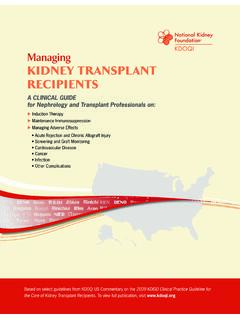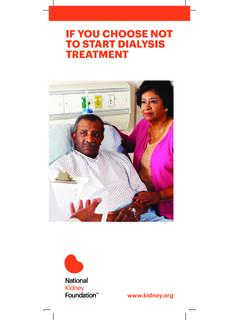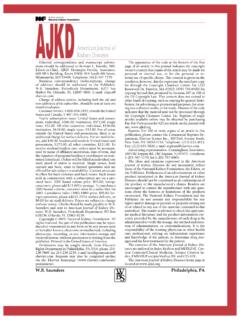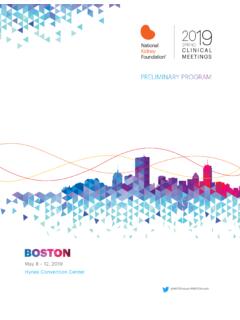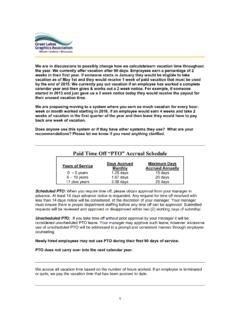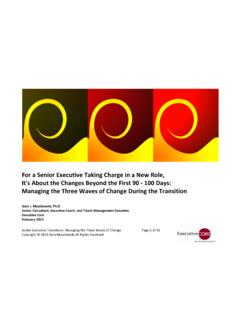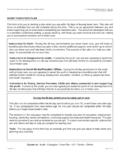Transcription of A“New Normal” - National Kidney Foundation
1 Helpful advicefrom people on dialysisA New normal : Life on Dialysis The first 90 Days30 East 33rd StreetNew York, NY 2007 National Kidney Foundation , Inc. All Rights X-XXXXXX-XX-X When I originally discovered that my kidneys were bad, I was The first time I had dialysis I had a hard time watching my blood leave my body. Now that I have been doingdialysis for 10 months, I am fine with it. a new normal : Life on Dialysis The first 90 DaysSupported by an educational grant fromDedicationTo all people with Kidney failure, and their families, who have recently entered the new and unfamiliar world of dialysis. Special thanks to:The many people who shared their experiences and innermost thoughts about their lives on Corr, PhD, for contributing to this book.
2 My friends and family are an emotional support, but in the end, I have to depend onme. It s my responsibility, my body, my life. Table of ContentsIntroduction .. 4 What to Expect in the first Few Months .. 6 What is Dialysis and How Does it Work?.. 7 Hemodialysis .. 7In-Center Dialysis .. 9 Home Dialysis .. 10 Peritoneal Dialysis.. 12 Passing the Time During Dialysis Treatments.. 14 Emotional Health.. 15 Challenges Associated with Being on Dialysis.. 15 Ways to Cope .. 17 Depression .. 20 Quality of Life .. 20 Physical Health.. 21 Lab Tests .. 29 Other Diagnostic Tests.. 332 Support Systems.. 35 Your Spouse or Life Partner .. 36 People Who Are Already on Dialysis .. 36 Family Members, Friendsand Co-Workers .. 37 Spiritual Support .. 39 When There is a Child in the Family.
3 40 Communicating with Your Dialysis Care Team.. 42 Employment, Travel and Activitiesof Daily Living.. 45 Can I Travel While on Dialysis? .. 46 Can I Continue to WorkWhile on Dialysis?.. 48 Children on Dialysis.. 50 Kidney Failure and Your Child s Growthand Development .. 51 Summary.. 54 Suggested Resources.. 5534 Living on dialysis can be challenging. Manyissues demand your attention as you develop new normals in your life. This booklet canhelp you learn about what to expect and howto address the issues you might have been living with chronic Kidney disease (CKD)for some time. Now your kidneys have failed and youhave recently started dialysis treatments. Having to go ondialysiswas no doubt difficult for you and your loved , living with a chronic illness often helps peoplelearn how to cope with new and unfamiliar booklet is for new dialysis patients.
4 The informationcomes from people who have recently started covered include adjusting to dialysis, what toexpect in the first few months, emotional and physicalhealth while on dialysis, support systems, managing cardiovascular disease and other conditions, lab values,employment, travel, daily living activities and cope with difficult times first few weeks are usually the hardest,but as time passes people adjust to new situations in their own ways. I was afraid. Now I am doing fine and amvery comfortable doing peritoneal dialysis. I was an emotional mess but I am coping. I felt scared. I feel good about it now. When I originally discovered that my kidneyswere bad, I was The first time Ihad dialysis I had a hard time watching myblood leave my body.
5 Now that I have beendoing dialysis for 10 months, I am fine with it. Dialysis can be hard to cope with, but it s worthit to have one more day with your family. Most of us feel fear and unease, followed by acceptance,and in some cases, positive feelings about the to Expect in the first Few Months I don t enjoy dialysis, but considering thealternative, I accept it. Unless someone is on dialysis themselves, or has a friendor loved one on dialysis, the average person knows verylittle about we know dialysis can be a life-savingtreatment,we may not fully understand that it can also be a life-changingexperience. For many of us with Kidney failure,dialysis greatly improves our quality of life. However, forsome of us, it may not, because of the seriousness of ourhealth if your health problems are different from someoneelse s, it s likely that you have many things in common,including an unfamiliar world with new routines, new setsof rules, people you have never met before, a differentlanguage, strange machines and many tests.
6 WHAT IS DIALYSIS AND HOW DOES IT WORK? Dialysis is a treatment that does some of the things normally done by healthy kidneys. Dialysis is neededwhen your kidneys don t work well enough to keep youhealthy. Dialysis: removes waste products, salt and extra water to prevent them from building up in the body; helps keep a safe level of certain chemicals in yourblood, such as potassium, sodium, bicarbonate, calciumand phosphorous; helps to control blood pressure, and helps in red blood cell production to correct are two types of dialysis: hemodialysis and peritoneal hemodialysis, an artificial Kidney (hemodialyzer) is used to remove waste products, extra chemicals and fluid from your rapidly remove the blood from your body into theartificial Kidney and back, a physician needs to make anaccess (entrance) into your blood vessels.
7 This is done byminor surgery to an arm or leg. Ideally, an access is madeby joining an artery to a vein under the skin to make abigger blood vessel; this type of access is called a fistula is considered the first and best choice forhemodialysis access, because it has the lowest chance , if your blood vessels are not adequate for a fistula, the doctor may use a soft plastic tube to join anartery and a vein under your skin. This is called a graft. Graft8 Sometimes an access is made with a thin plastic tube,called a catheter, which is inserted into a large vein in theneck. This type of access is usually temporary, but may beused for long-term treatment only if a fistula or graft cannot be treatments involve a lot of your time. The time needed for your dialysis depends on: how much fluid weight you gain between treatments how much waste products you have in your body your size (which determines the amount of waste products your cells make) the type of artificial Kidney used.
8 Hemodialysis can be done in a dialysis center, in a hospital s dialysis unit, or at home. IN-CENTER HEMODIALYSISH emodialysis can be received in a facility that is either partof a hospital (called a dialysis unit), or in an independentdialysis center. A lot of time is spent at the dialysis facility(approximately three times per week for three to fourhours each time). It may take some time to get used tothis new experience. Hopefully, you had a chance to visityour dialysis center and ask questions before startingtreatment. If not, it s never too late to ask questions andexpress your first , the staff at the dialysis facility, and the otherpatients, will seem like strangers. The surroundings arenew and unfamiliar, and you may experience negativefeelings about having to spend so much time at the , with patience and support from your loved ones and the dialysis team, your sessions will soon become afamiliar routine.
9 It surprised me that so many people were ondialysis. The staff made me comfortable andthe other patients seemed to be okay with the treatment. Coming from home dialysis to a unit wastroublesome but they allowed me to continuejust as if I was at home. HOME HEMODIALYSISH emodialysis can be performed at home. You may do thetreatments yourself or you may have someone helping hemodialysis may help you to fit your treatmentsinto your daily schedule. Studies show that the more aperson knows about treatment and the more independenta person is, the better one is likely to do on types of hemodialysis can be performed at are:1. Conventional home hemodialysis:This is done threetimes a week for three to four hours or longer each and your care partner are trained to do dialysissafely and to handle any problems that may come may take several weeks to a few months.
10 2. Short daily home hemodialysis:This is usually donefive to seven times a week using machines designed forshort, daily home treatment. Treatments usually lastabout two hours each. You and your care partner aretrained over several weeks. Because dialysis is donemore often, less fluid generally needs to be removedeach time. This reduces symptoms like headaches, nausea, cramping and feeling washed out after treat-ment. In addition, control of certain blood chemicals,such as phosphorus, is much better with daily Nocturnal home hemodialysis:These are long, slowtreatments done at night while sleeping. It may bedone six nights a week or every other night, dependingon what your doctor prescribes for you. Treatmentsusually last about six to eight hours.

